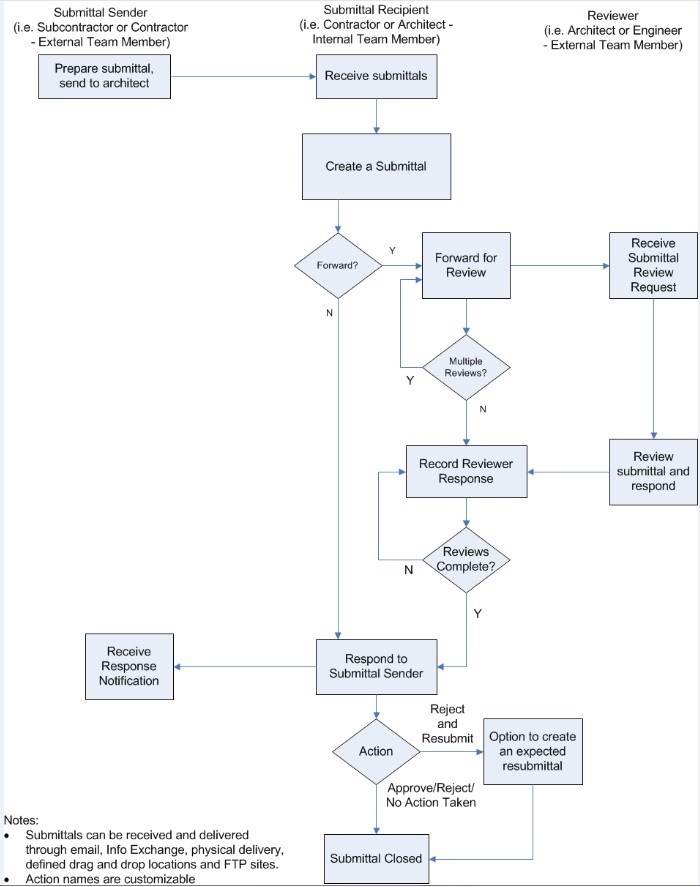Submittals Overview
The Submittals activity center enables you to effectively log submittals and track them through their approval process. It provides a way to track the status of active submittals throughout the review cycle. By logging the files, email messages, and actions associated with each submittal, Project Center plays an important role in settling any conflicts that inevitably arise during or after construction.
As a part of contract management, the Submittals activity center enables you to receive, file, review, and track submittals electronically. You can log and track electronic file transfers (whether done via Info Exchange, email, or a drag and drop site) or physical transfers of information (such as product samples and paper drawings) for each project.
1 See New and Improved Features in Newforma Project Center for the latest updates to submittals.
Use the Submittals activity center to:
-
Enter submittals into the submittal log, whether they are files or physical materials related to a specified construction requirement either by:
-
-
Creating the submittal if you originate submittals;
-
Logging a received submittal if it was sent to you.
-
-
Forward submittals to internal or external project team members for review;
-
Respond to submittal senders or simply close a submittal without a response;
-
Record the exchange of physical materials related to a specified construction requirement;
-
Track each submittal’s action status;
-
Manage the submittal log:
-
Sort the log by due date, today days, etc.;
-
Quickly see which submittals require attention;
-
Create reports.
-
Set project standards and create email/form templates to conform to your existing practice;
-
Receive automatic reminders for submittals that are nearing their due date.
-
Associate email messages and supporting documents with a submittal.
-
Schedule an expected submittal. When new submittals arrive, you then have the option to create a new submittal or associate it with an expected submittal;
-
Create an expected resubmittal automatically when a submittal's status is set to Revise and Resubmit. Resubmitted submittals are linked to the previous submittals.
-
Set the action to Approved, Rejected, No Action Taken, For Review, Revise and Resubmit, etc.;
-
Sort and track submittals by specification section.
Submittals have an Email Log for tracking email messages. Use it to view related email and file email messages sent among consultants, contractors, and the project team to a submittal.
Info Exchange support
Within Info Exchange, external project team members can send submittals and review submittals that were forwarded to them for review. Internal project team members can review submittals and track submittals using the full submittal log in Info Exchange, enabling you to track the submittal process via the web from any location.
1 Project Center users viewing the Submittals log in Info Exchange will see the full log and all associated actions. Users logging into Info Exchange who are not Project Center users will only see the actions on which they are listed. These settings can be changed in the Groups and Info Exchange tab of the Modify Project Team Member dialog box.
Workflow

Submittal packages workflow
General background information about submittals
Submittals play a significant role in the construction administration phase of a project. Prior to this phase, a project's focus is on creating the detailed design documentation, which includes drawings and construction specifications. The drawings and specs are then distributed to general contractors (GCs) who bid on the job. The GC who wins the job is contractually obliged to deliver a building that adheres to the guidelines defined in the drawings and specifications. But many of these guidelines are loosely defined and require input from the sub-contractors during the construction administration phase to be finalized.
This is where the formal submittal process comes in. The GC solicits submittals from subcontractors and suppliers for each requirement defined in the construction drawings and details. These submittals can include:
-
Physical samples (such as marble, tile, carpet, paint, etc.);
-
Shop drawings (such as detailing installation of equipment, structural elements, curtainwall assembly, etc.);
-
Manufacturer’s specifications or brochures.
The GC then submits these items as a submittal to the architect for approval, along with a due date for a response back. (The due date is the date the reply has to be received by the GC so that progress can continue.) Typically, there is a single person at the architectural firm that logs and tracks these submittals. Sometimes, the architect approves the submittal. Other times, it requires approval from a domain specialist, such as a structural engineer, mechanical engineer, a LEED consultant, or the client or building owner. In these cases, the architect forwards the submittal to one or more domain specialists under the cover of a submittal transmittal. The domain experts then review the submittal and return their comments to the architect who assembles everyone’s comments into a coordinated response and action for the general contractor. The action is typically either: 1) Approved, 2) Rejected, or 3) No Action Taken. A rejected action identifies any problems with the original submittal and includes recommendations for re-submittal.
For example, a carpet sample that is going to be used in an office building is submitted to the architect. The architect must decide whether or not the carpet meets the requirements. In order to answer the question, the architect may need to ask the person who is paying for the project (the owner.) To do this, the architect may have to forward the sample to the owner for an external review before responding to the GC.
The following chart shows an overview of the submittal process:


